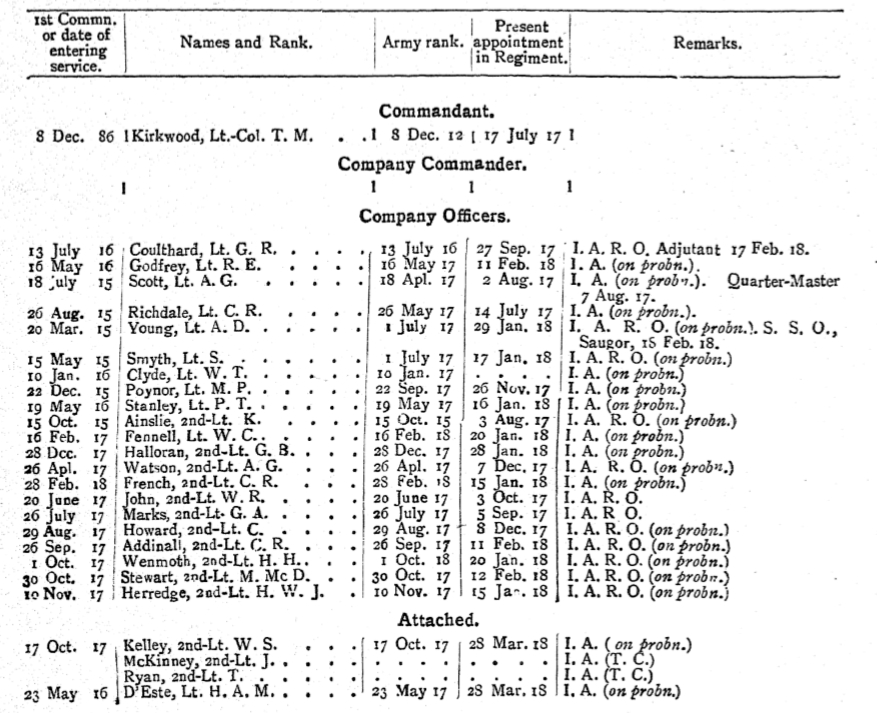This article on the 2nd Battalion 94th Russell’s Infantry aims to help you research this short-lived Indian infantry battalion and those who served with it during the First World War. I have written a separate article for the 1st Battalion 94th Russell’s Infantry and also a series of guides to help you research soldiers who served in the Indian Army during the war. The links below will take you to the guides:
- Guide to the 2nd Battalion 94th Russell’s Infantry
- Guides to Researching Soldiers who Served in the Indian Army
The 2nd Battalion 94th Russell’s Infantry in the First World War
Lineage: The 2nd Battalion 94th Russell’s Infantry was formed at Saugor (Sagar, Madhya Pradesh, India) on 11 June 1917 and disbanded on 31 December 1920. For a history of the Regiment’s lineage see my page on the 1st Battalion 94th Russell’s Infantry.
Class Composition of Battalion in 1919: 1/2 a Company of Dekhan Muslims, 1 and a 1/2 Companies of Rajputs, 1 Company of Jats and 1 Company of Ahirs.
The 2nd Battalion 94th Russell’s Infantry was a short-lived Indian infantry battalion formed at Saugor (Sagar, Madhya Pradesh, India) on 11 June 1917. The Battalion’s first commanding officer was Lieutenant-Colonel Thomas Moore Kirkwood who was appointed on 17 July 1917. Below is an excerpt from the July 1918 Indian Army List which recorded the British officers serving with the Battalion at the time. Like other war-raised Indian units, the Battalion’s British officers were mostly Indian Army officers on probation (on probn.) or from the Indian Army Reserve of Officers (I.A.R.O.). There are usually a wide variety of records to consult for these officers.
The 2nd Battalion 94th Russell’s Infantry served with the Jubullpore Brigade and remained in India for the duration of the war. On 29 January 1918, the Battalion was inspected by Brigadier-General C. G. Prenderghast, Commanding Jubbulpore Brigade:
General efficiency: The unit has made great progress in recruiting and has enlisted large numbers, but its training is not so good as it should be, making allowances for the lack of accommodation and good instructors.
Confidential review reports on Indian Army units, depots, British officers, etc. for 1917-1918: IOR/L/MIL/7/17029
The Battalion was not mobilized during the Third Anglo-Afghan War (6 May – 8 August 1919) but served as part of Waziristan Force on the North West Frontier. There is a very short war diary covering the period between January and February 1920 but is very poor. While the Battalion served on the North West Frontier its Depot was at Saugor. The 2nd Battalion 94th Russell’s Infantry was disbanded on 31 December 1920.
War Diary of the 2nd Battalion 94th Russell’s Infantry
There is only one war diary for the 2nd Battalion 94th Russell’s Infantry which as of January 2018 has not been digitized and can only be viewed by visiting the National Archives. I have a copy of this war diary and have transcribed a few entries below.
- Date: 01 January – 29 February 1920
- Waziristan Force
- Reference: WO 95/5398
- Notes: It is unfortunate that the only war diary for the 2nd Battalion 94th Russell’s Infantry is only two months in length with very brief entries. Most entries concern the arrival and departure of various escorts and pickets.
Further Sources for the 2nd Battalion 94th Russell’s Infantry
For information regarding British and Indian officers who served with the 2nd Battalion 94th Russell’s Infantry the Indian Army List should be consulted. There are three confidential reports for the Battalion held at the British Library which also include the annual confidential reports of the British officers serving with it. Though the latter two reports are only for the Battalion’s Depot and the British officers serving with it:
- Confidential review reports on Indian Army units, depots, British officers, etc. for 1917-1918: IOR/L/MIL/7/17029
- Confidential review reports on Indian Army units, depots, British officers, etc. for 1918-1919: IOR/L/MIL/7/17030. Depot only.
- Confidential review reports on Indian Army units, depots, British officers, etc. for 1919-1920: IOR/L/MIL/7/17031. Depot only.
Extracts from War Diary of the 2nd Battalion 94th Russell’s Infantry
01 January – 29 February 1920, Waziristan Force, WO 95/5398
06 January 1920 – Orders received by telephone at 23.15 hours to fall in all available men and march at 01.30 hours 8th instant to 12 milestone Dera Ismail Khan Tank Road.
07 January 1920 – 300 other ranks fell in at 01.30 hours and met South Waziristan Militia t rendezvous column on Tank Road at 02.00 hours. Column under command Lieutenant-Colonel E. H. F. Apthorpe marched to 12 milestone Tank Road arriving at 05.50 hours.
06.15 hours. Deputy Commissioner D.I. Khan met column which proceeded to small encampment occupied by men who had previous day caused trouble. Encampment surrounded at dawn. Deputy Commissioner and Officer Commanding Column with a search party searched through encampment and at 12.30 hours succeeded in getting about 20 prisoners with 30 rifles. Column returned D.I. Khan 1800 hours.
10 January 1920 – A Company under Captain W. T. Clyde relieved B Company under command Captain Masters [?] in Fort Akalgarh. B Company proceeding to cantonment D. I. Khan for duty.
11 January 1920 – 3 Sections returned from escort duty Bannu and proceeded to fort to join A Company.
15 January 1920 – Escort 3 sections proceeded with 6 Bullock Corps to Gambila on Bannu Road.
27 January 1920 – One escort Jemadar Nanig Ram and 3 sections D Company proceeded in charge of Daraban-Kulachi convoy to Saggu.
28 January 1920 – Owing to move of South Waziristan Militia to Tank duties of detachment at D.I. Khan became very heavy.
20 February 1920 – Escort which proceeded to Saggu on 17 instant returned. One escort of 3 sections proceeded to Saggu in charge of an additional convoy required for Draban.

